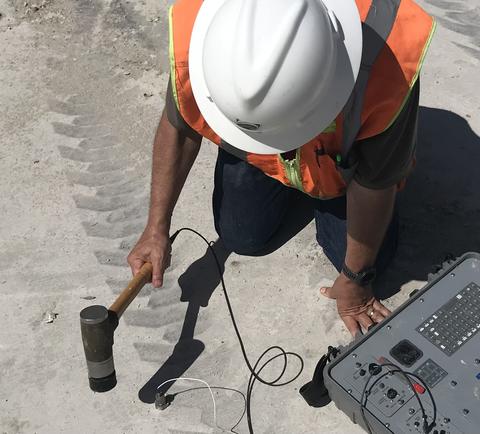
A geophysics specialist performs nondestructive testing, using an impulse echo, to support the evaluation of the integrity of the foundation.
NIST continues its investigative work, studying the geologic characteristics underneath the collapsed building site, as well as the properties of the building’s foundation system. The subsurface investigation includes standardized procedures for monitoring the groundwater, as well as field and laboratory testing of the soil and rock. Field testing will seek to shed light on how the subsurface soil layers vary in depth below the building and across the building’s footprint. This will include performing standard penetration testing to reveal the stiffness of different layers of soil and creating small-diameter (5-centimeter, or 2-inch) boreholes to collect soil samples that can be used for determining the general characteristics and type (e.g., sand, clay, rock) of soil deposits, the general soil classification, the size of the grains within the soil mass, and soil strength characteristics.
Rock core samples will also be collected from these boreholes to assess rock quality and structure. NIST will complement this testing with other standardized instruments such as cone penetrometers, which are pushed into the soil to reveal its type and strength properties without taking any samples. Geophysical methods that send very low intensity waves (e.g., impulse echo and ground penetrating radar) into the ground or the foundations will be used to obtain information about the condition of the foundation and its surrounding soil with minimal disturbance to the site conditions.
The NIST team is collecting additional data relating to the type and integrity of the foundations, their connection to the structure, and the strength and condition of the structural materials used to support the building. The samples collected using these procedures will be preserved as evidence supporting the technical investigation. The fieldwork is expected to be finished within a few weeks, assuming no major interruptions on the site. The NIST field and laboratory testing will be augmented by a review of historic, geologic, design and construction information to characterize the below-ground site conditions, examine any potential geo-hazards, and generate engineering parameters for the modeling of the building to investigate the causes of the collapse.

